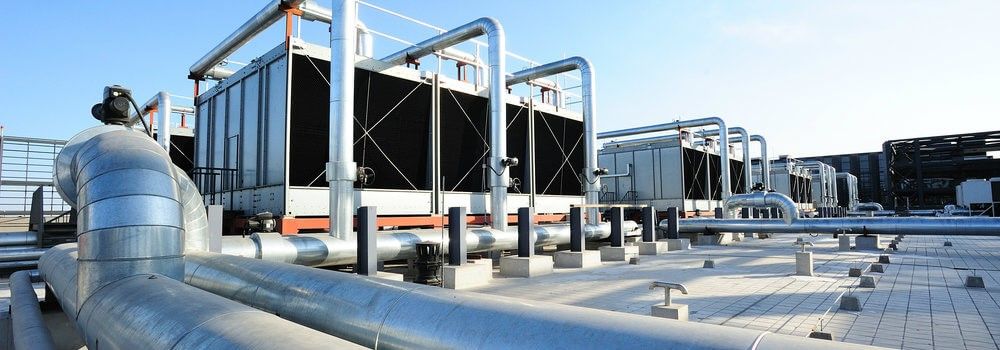Air-cooled Chillers:
Air-cooled chillers are a popular kind of chiller because they are straightforward to install. By blowing air over the condenser coils with the help of big fans, these systems rely on ambient air to chill the refrigerant. Heat from the refrigerant is released into the atmosphere during this process.
· Benefits:
The ease of installation of air-cooled chillers is one of its main advantages. Their lack of a separate cooling tower and heavy plumbing requirements simplify setup and save initial expenses. These chillers are a good option for places where water is expensive or limited because they also depend less on water resources.
· Cons:
Air-cooled chillers are less efficient than water-cooled systems in high ambient temperatures, regardless of their benefits. Particularly in areas with high temperatures, this inefficiency may lead to increased operating expenses. Additionally, the air-cooled chiller’s fans can make a lot of noise, which could be problematic in settings where noise levels must be kept to a minimum.
Water-Cooled Chillers:
Water is used in water-cooled chillers to both absorb and reject heat from the refrigerant. To enable the chiller to continue operating efficiently even when there are large loads, these systems usually have a cooling tower where the water rejects heat to the atmosphere.
· Benefits:
Water-cooled chillers have a reputation for being extremely efficient, particularly when used for large-scale cooling. They are used for large industrial processes or buildings with high cooling demands because they typically outperform air-cooled chillers in high-load scenarios. Furthermore, because the cooling towers are frequently placed far from inhabited areas, they function more silently than air-cooled systems.
· Cons:
Because water-cooled chillers require additional infrastructure, such as a cooling tower and related water treatment facilities, their initial cost is typically higher. They also require a steady supply of water, which can be difficult in areas with little water supplies. To stop problems like scaling and bacterial growth, regular maintenance of the water treatment and cooling tower systems is crucial.
Centrifugal Chillers:
Centrifugal chillers are intended for large-scale industrial and commercial settings where substantial cooling capacity and great efficiency are necessary. The pressure of the refrigerant, which circulates throughout the system to absorb and release heat, is increased in these chillers by a centrifugal compressor.
· Benefits:
Centrifugal chillers can handle heavy cooling loads with relative ease and have a high efficiency. Large industrial facilities, data centres, and commercial buildings frequently employ them. Despite their higher initial cost, these chillers’ efficiency can eventually result in cheaper operating costs.
· Cons:
Centrifugal chillers’ complexity can be a disadvantage because it necessitates specialized maintenance and repair frequently. For certain businesses, their relatively high initial purchase cost may also be a barrier. Furthermore, these chillers are less suitable for smaller installations and are typically best suited for applications needing substantial capacity.
Screw Chillers:
Screw chillers are a common option for medium- to large-scale cooling applications since they compress the refrigerant using a rotary screw compressor. These systems are well-known for being dependable and effective, especially in commercial environments.
· Benefits:
Screw chillers have several advantages, including great efficiency and dependability. At smaller capacities, they can be more energy-efficient than centrifugal chillers and can handle a variety of load circumstances. Their design makes it possible for the equipment to operate smoothly and with less vibration, which extends its lifespan.
· Cons:
Screw chillers might be more expensive than other types of chillers, despite their efficiency. In addition to being complicated, maintenance and repair may require for specific parts and expertise. Furthermore, even if they operate efficiently at moderate to high capacities, in very large-scale applications, their efficiency could not be as great as that of centrifugal chillers.
FAQs:
1. What Are the Benefits of Using Absorption Chillers in HVAC Systems?
Absorption chillers are an energy-efficient choice for buildings with waste heat or a wealth of thermal energy sources since they run the refrigeration cycle using heat rather than mechanical energy. Reduced electricity use, cheaper operating expenses, and the capacity to use waste heat from industrial processes or combined heat and power (CHP) systems are some advantages. Additionally, absorption chillers require less maintenance because they are quieter and have fewer moving parts.
2. How Can Oil Migration in a Chiller System Be Prevented?
As oil can coat heat exchange surfaces and impede refrigerant flow, it can cause oil migration in chiller systems, which can result in decreased efficiency and possible component damage. Make sure the oil return system is operating properly so that oil may return to the compressor without collecting in the condenser or evaporator and causing oil migration. Check the oil separators’ condition and oil levels regularly.
3. How Can Refrigerant Leaks Affect Chiller Systems?
For chiller systems, refrigerant leaks can have detrimental effects on the environment, higher energy costs, and decreased cooling capability. Because of leaks, the system runs with an inadequate charge of refrigerant, which results in inefficient heat transfer and overworked compressors. Use dye tests, ultrasonic sensors, or electronic detectors for routine leak detection inspections to help reduce this.
4. How Can I Improve Chiller Performance Using Data Analytics?
The utilisation of data analytics can significantly improve the performance of chillers by offering valuable insights into system functioning and pinpointing inefficiencies. Facility managers can identify patterns that point to possible problems, including underperformance during peak loads or irregular cycling, by gathering and evaluating data on variables like temperature, pressure, flow rates, and energy consumption. By predicting maintenance requirements before breakdowns happen, predictive analytics can assist minimize downtime.


